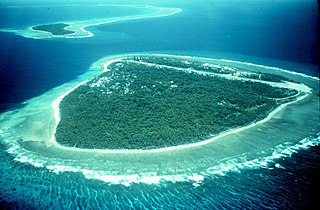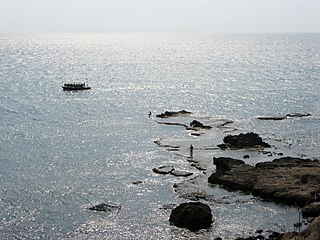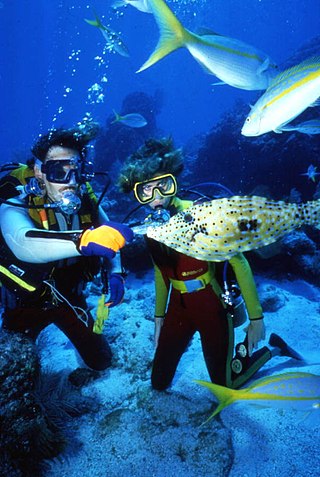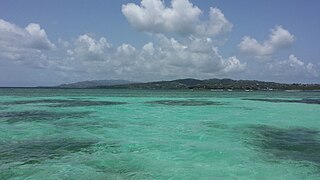
The Caribbean Sea is a sea of the North Atlantic Ocean in the tropics of the Western Hemisphere, located south of the Gulf of Mexico and southwest of the Sargasso Sea. It is bounded by the Greater Antilles to the north from Cuba to Puerto Rico, the Lesser Antilles to the east from the Virgin Islands to Trinidad and Tobago, South America to the south from the Venezuelan coastline to the Colombian coastline, and Central America and the Yucatán Peninsula to the west from Panama to Mexico. The geopolitical region centered around the Caribbean Sea, including the numerous islands of the West Indies and adjacent coastal areas in the mainland of the Americas, is known as the Caribbean.

The Great Barrier Reef is the world's largest coral reef system, composed of over 2,900 individual reefs and 900 islands stretching for over 2,300 kilometres (1,400 mi) over an area of approximately 344,400 square kilometres (133,000 sq mi). The reef is located in the Coral Sea, off the coast of Queensland, Australia, separated from the coast by a channel 160 kilometres (100 mi) wide in places and over 61 metres (200 ft) deep. The Great Barrier Reef can be seen from outer space and is the world's biggest single structure made by living organisms. This reef structure is composed of and built by billions of tiny organisms, known as coral polyps. It supports a wide diversity of life and was selected as a World Heritage Site in 1981. CNN labelled it one of the Seven Natural Wonders of the World in 1997. Australian World Heritage places included it in its list in 2007. The Queensland National Trust named it a state icon of Queensland in 2006.

Ecotourism is a form of nature-oriented tourism intended to contribute to the conservation of the natural environment, generally defined as being minimally impactful, and including providing both contributions to conservation and environmental education. The definition sometimes also includes being financially beneficial to the host community or making conservation financially possible. There are a range of different definitions, and the correct definition of the term was an active subject of debate as of 2009. The term is also used more widely by many organizations offering nature tourism, which do not focus on being beneficial to the environment.

The geography of Aruba, located at the juncture of the South American and Caribbean tectonic plates, has been shaped by a complex interplay of geological processes. From its flat expanses to its rugged coastlines, Aruba's geography and geology reveal the island's geographical diversity and its underlying geological formations, offering a comprehensive understanding of Aruba's terrain and environmental dynamics of this Caribbean destination.

Southeast Asian coral reefs have the highest levels of biodiversity for the world's marine ecosystems. They serve many functions, such as forming the livelihood for subsistence fishermen and even function as jewelry and construction materials. Corals inhabit coastal waters off of every continent except Antarctica, with an abundance of reefs residing along Southeast Asian coastline in several countries including Indonesia, the Philippines, and Thailand. Coral reefs are developed by the carbonate-based skeletons of a variety of animals and algae. Slowly and over time, the reefs build up to the surface in oceans. Coral reefs are found in shallow, warm salt water. The sunlight filters through clear water and allows microscopic organisms to live and reproduce. Coral reefs are actually composed of tiny, fragile animals known as coral polyps. Coral reefs are significantly important because of the biodiversity. Although the number of fish are decreasing, the remaining coral reefs contain more unique sea creatures. The variety of species living on a coral reef is greater than anywhere else in the world. An estimation of 70-90% of fish caught are dependent on coral reefs in Southeast Asia and reefs support over 25% of all known marine species.

Shark tourism is a form of eco-tourism that allows people to dive with sharks in their natural environment. This benefits local shark populations by educating tourists and through funds raised by the shark tourism industry. Communities that previously relied on shark finning to make their livelihoods are able to make a larger profit from diving tours while protecting the local environment. People can get close to the sharks by free- or scuba diving or by entering the water in a protective cage for more aggressive species. Many of these dives are done by private companies and are often baited to ensure shark sightings, a practice which is highly controversial and under review in many areas.

Tourism is one of the Caribbean's major economic sectors, with 25 million visitors contributing $49 billion towards the area's gross domestic product in 2013, which represented 14% of its total GDP. It is often described as, "the most tourism-dependent region in the world".

Cruise ships carrying several thousand passengers and crew have been compared to “floating cities,” and the volume of wastes that they produce is comparably large, consisting of sewage; wastewater from sinks, showers, and galleys (graywater); hazardous wastes; solid waste; oily bilge water; ballast water; and air pollution. The waste streams generated by cruise ships are governed by a number of international protocols and U.S. domestic laws, regulations, and standards, but there is no single law or rule. Some cruise ship waste streams appear to be well regulated, such as solid wastes and bilge water. But there is overlap of some areas, and there are gaps in others.

Reef Check is an international non-governmental organization dedicated to the conservation of two reef ecosystems: tropical coral reefs and Californian rocky reefs. The Foundation is headquartered in Los Angeles, California, United States, but uses data from volunteer scuba diver teams in over 80 countries, ranging from Australia, Japan, to even Germany. It is the United Nations’ official coral reef monitoring program.
Tourism in Dominica consists mostly of hiking in the rain forest and visiting cruise ships.

Cinque Terre National Park is a protected area inducted as an Italian national park in 1999. Located in the province of La Spezia, Liguria, northern Italy, it is the smallest national park in Italy at 4,300 acres, but also the densest with 5,000 permanent inhabitants among the five towns. In addition to the territory of the towns of Cinque Terre, the Cinque Terre National Park encompasses parts of the communes of Levanto and La Spezia. Cinque Terre was included as a UNESCO World Heritage Site in 1999.

Human activities have substantial impact on coral reefs, contributing to their worldwide decline. Damaging activities encompass coral mining, pollution, overfishing, blast fishing, as well as the excavation of canals and access points to islands and bays. Additional threats comprise disease, destructive fishing practices, and the warming of oceans.[2] Furthermore, the ocean's function as a carbon dioxide sink, alterations in the atmosphere, ultraviolet light, ocean acidification, viral infections, the repercussions of dust storms transporting agents to distant reefs, pollutants, and algal blooms represent some of the factors exerting influence on coral reefs. Importantly, the jeopardy faced by coral reefs extends far beyond coastal regions. The ramifications of climate change, notably global warming, induce an elevation in ocean temperatures that triggers coral bleaching—a potentially lethal phenomenon for coral ecosystems.

Tourism is one of the major industries in the Great Barrier Reef region. Approximately 2.19 million people visit the Great Barrier Reef each year. According to the WWF, tourism of the area contributes $5.89 billion a year to the Australian economy, and employs approximately 69,000 people. Ove Hoegh-Guldberg sees the key competitive advantage of the Great Barrier Reef as opposed to other, closer, reef tourism destinations is the region's reputation as being "the most pristine coral reef on the planet". The GBRMPA states that careful management, which includes permits for camping and all commercial marine tourism within the Great Barrier Reef Marine Park, seeks to ensure that tourists have minimal impact on the reef. However, rising incidences of widespread coral bleaching, coastal development, and tourism impacts have taken a toll the biodiversity of the reef.

A variety of factors affect the water and marine life along the coastline of Lebanon, including marine pollution, environmental impact of shipping, oil spills, noxious liquid substances spills, sewage spills, and the dumping of radioactive and medical waste.
Tourism impacts tourist destinations in both positive and negative ways, encompassing economic, political, socio-cultural, environmental, and psychological dimensions.

Scuba diving tourism is the industry based on servicing the requirements of recreational divers at destinations other than where they live. It includes aspects of training, equipment sales, rental and service, guided experiences and environmental tourism.

The environmental impact of recreational diving is the effects of recreational scuba diving on the underwater environment, which is largely the effects of diving tourism on the marine environment. It is not uncommon for highly trafficked dive destinations to have more adverse effects with visible signs of diving's negative impacts due in large part to divers who have not been trained to sufficient competence in the skills required for the local environment, an inadequate pre-dive orientation, or lack of a basic understanding of biodiversity and the delicate balance of aquatic ecosystems. There may also be indirect positive effects as the environment is recognised by the local communities to be worth more in good condition than degraded by inappropriate use, and conservation efforts get support from dive communities who promote environmental awareness, and teach low impact diving and the importance of respecting marine life. There are also global coral reef monitoring networks in place which include local volunteer divers assisting in the collection of data for scientific monitoring of coral reef systems, which may eventually have a net positive impact on the environment.

Jamaica, an island located within the Caribbean Sea, known for being a popular tourist destination because of its pristine white sand beaches, is now faced with the issue of mass coral depletion. Both environmental and human factors contribute to the destruction of these corals, which inevitably affect Jamaica's environmental sustainability and economy. Actions have been put in place to counteract the negative consequences associated with the loss of the corals, which act as a symbol of hope for the revival of Jamaica's environment.

The island of Tobago has multiple coral reef ecosystems. The Buccoo Reef, the Culloden Reed and Speyside Reef are the three largest coral reef marine ecosystems in Tobago. The Buccoo Reef is a coralline reef ecosystem that is located on the southwestern region of Tobago. It is a popular ecotourism attraction where tourists can snorkel and see the coral reefs and schools of fish without diving equipment. The Trinidad and Tobago Tourism Ministry estimates that 90% of its tourists visit the Buccoo Reef while exploring Tobago. The Buccoo Reef, also known as the Buccoo Reef Complex, spans 7 km2 and has five reef flats that can reach up to 25 metres in depth. The reef complex has been designated as part of a protected Ramsar site since 2005.
The Convention for the Protection and Development of the Marine Environment of the Wider Caribbean Region, commonly called the Cartagena Convention, is an international agreement for the protection of the Caribbean Sea, the Gulf of Mexico and a portion of the adjacent Atlantic Ocean. It was adopted on 24 March 1983, entered into force on 11 October 1986 subsequent to its ratification by Antigua and Barbuda, the ninth party to do so, and has been ratified by 26 states. It has been amended by three major protocols: the Protocol Concerning Co-operation in Combating Oil Spills in the Wider Caribbean Region, the Protocol Concerning Specially Protected Areas and Wildlife to the Convention for the Protection and Development of the Marine Environment of the Wider Caribbean Region and the Protocol Concerning Pollution from Land-Based Sources and Activities to the Convention for the Protection and Development of the Marine Environment of the Wider Caribbean Region.



















